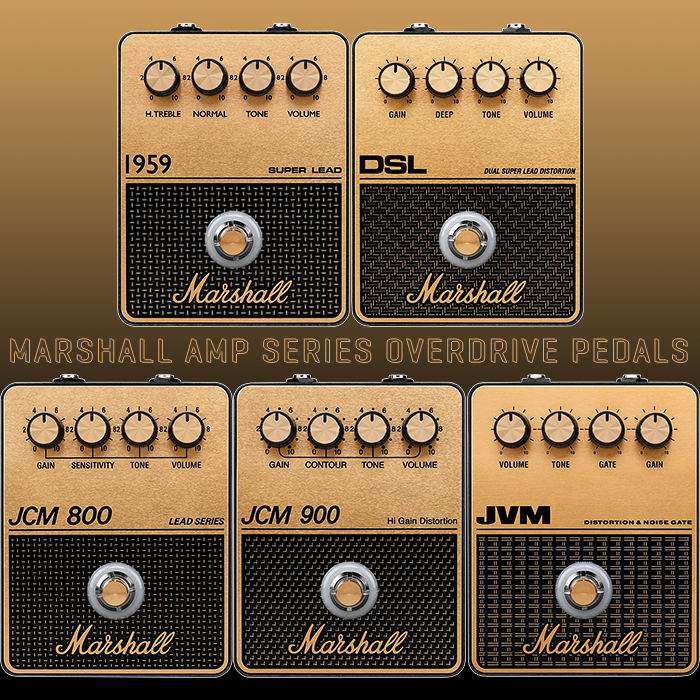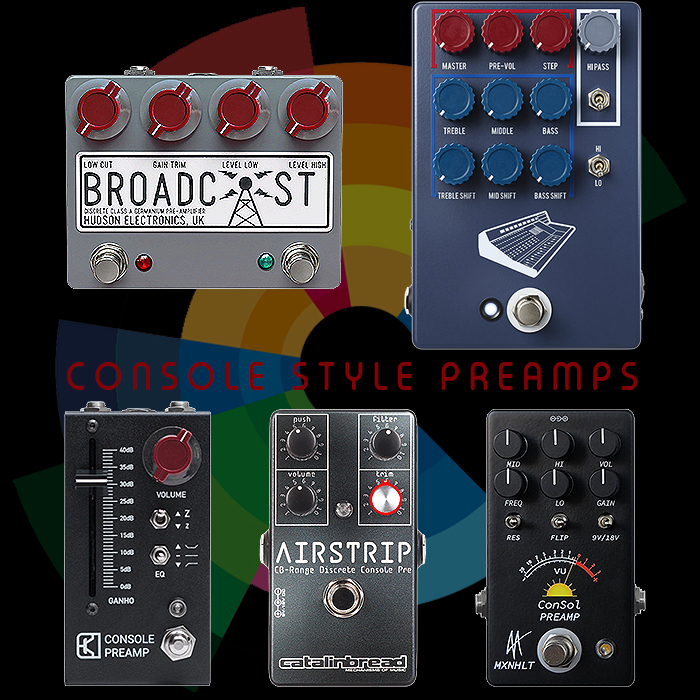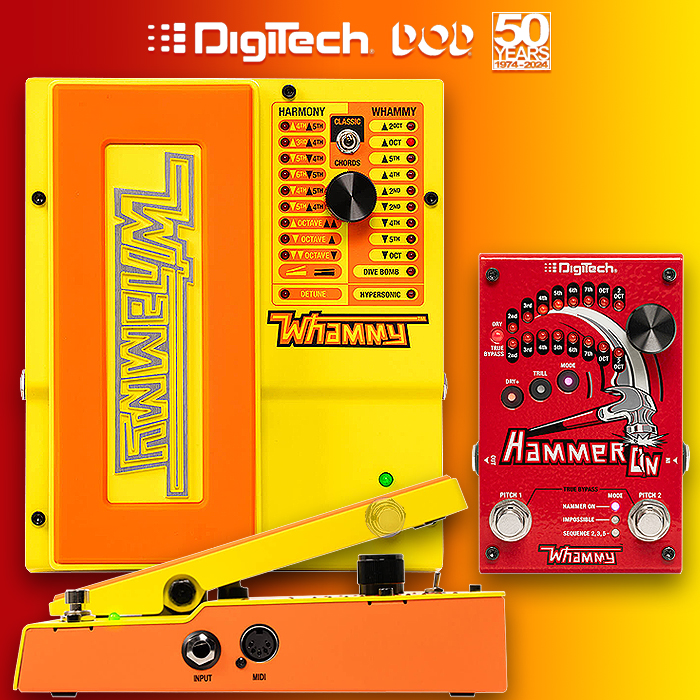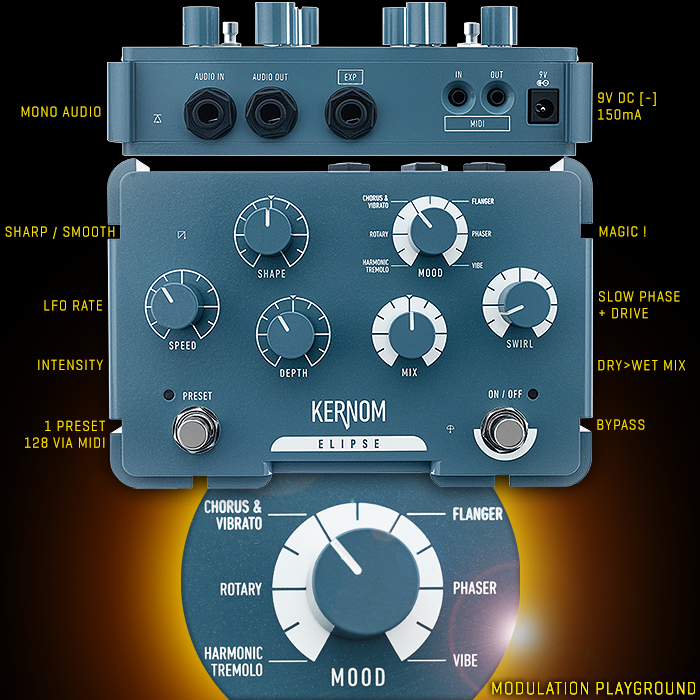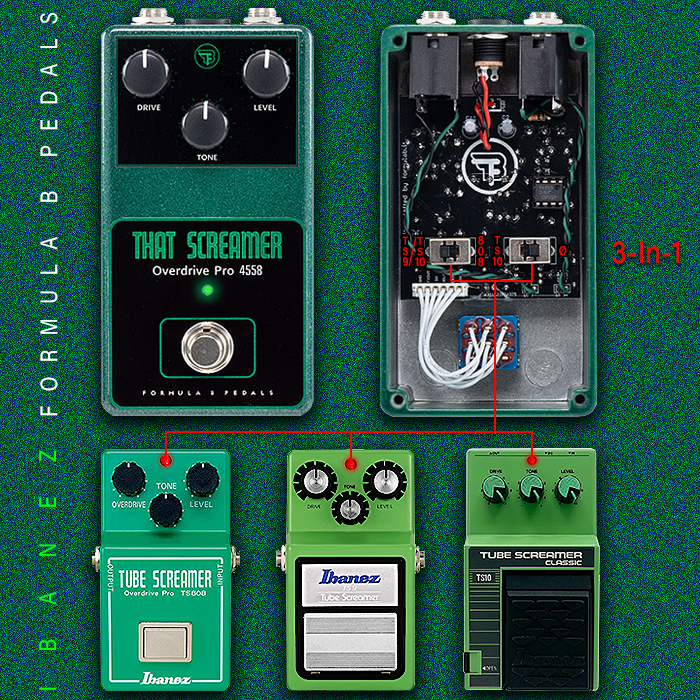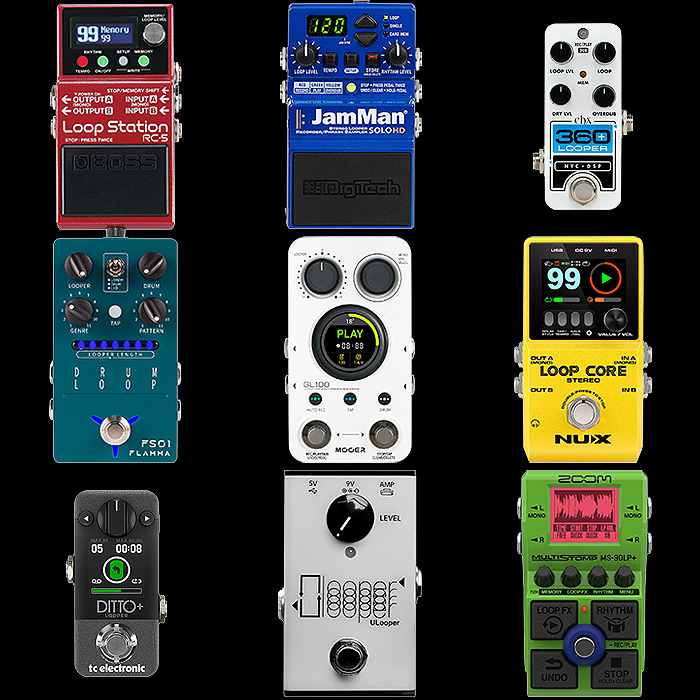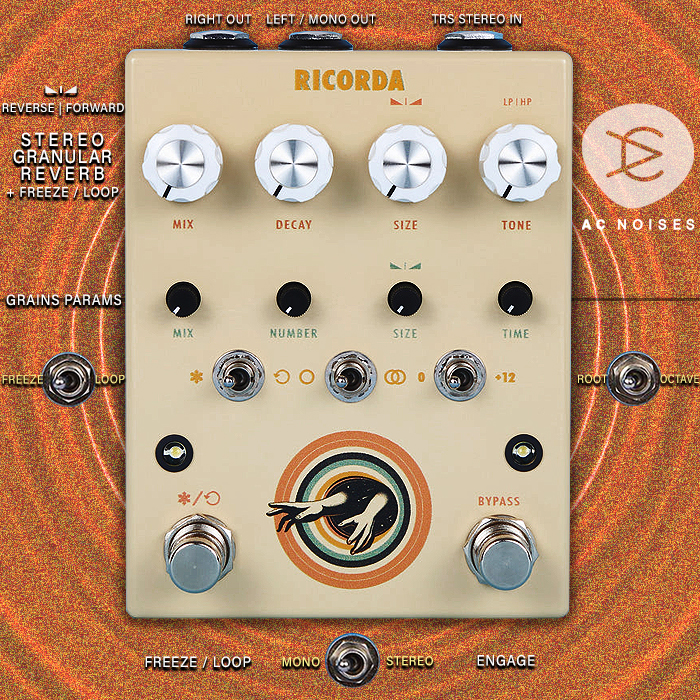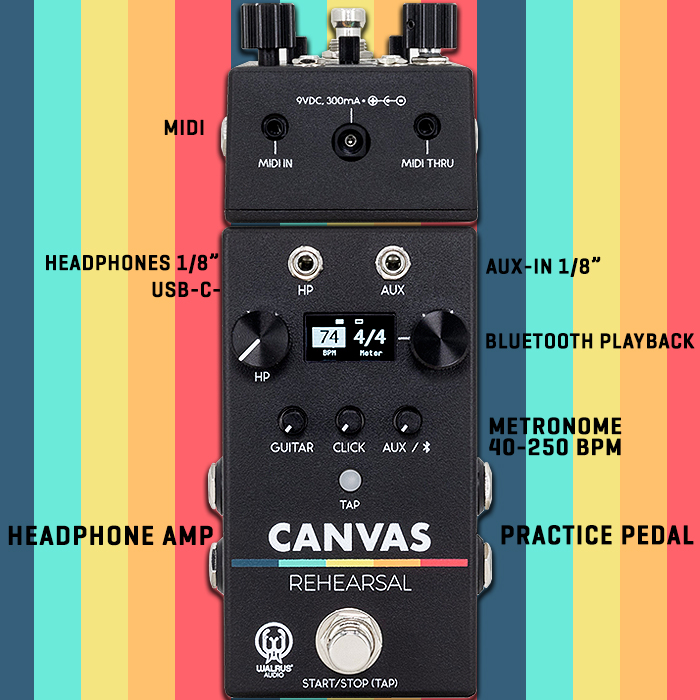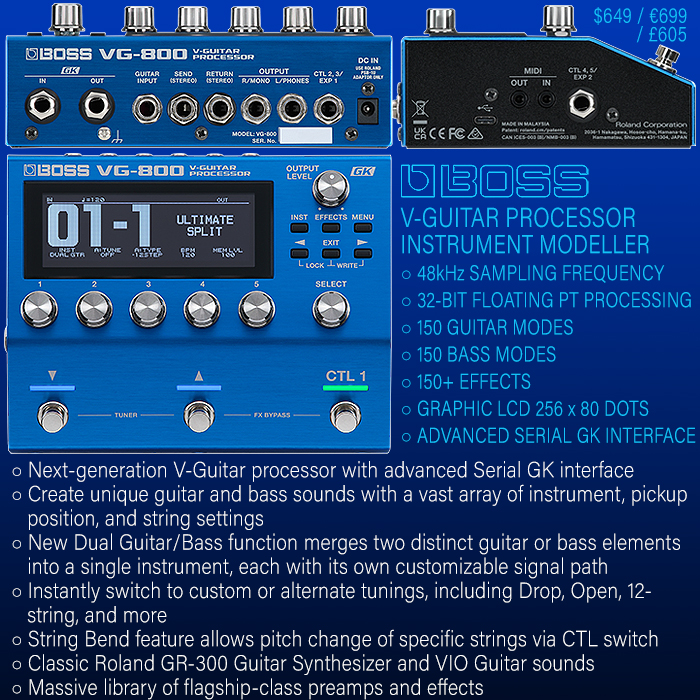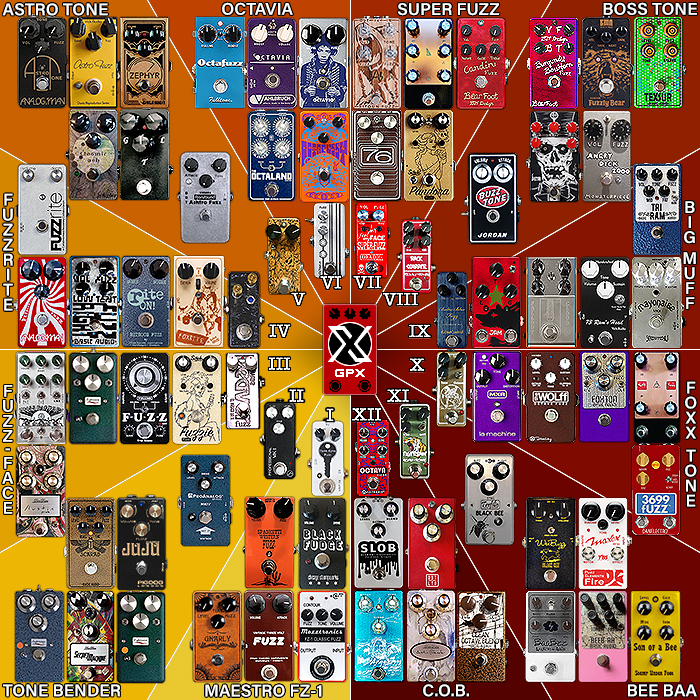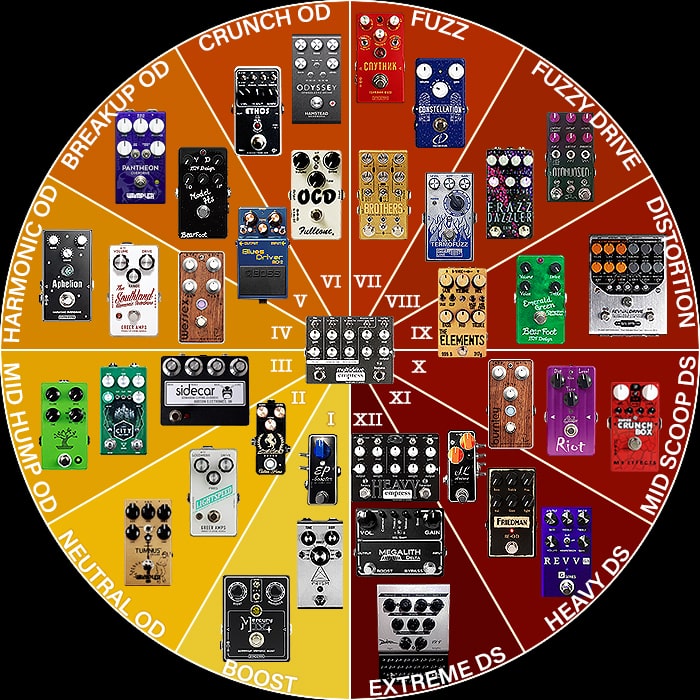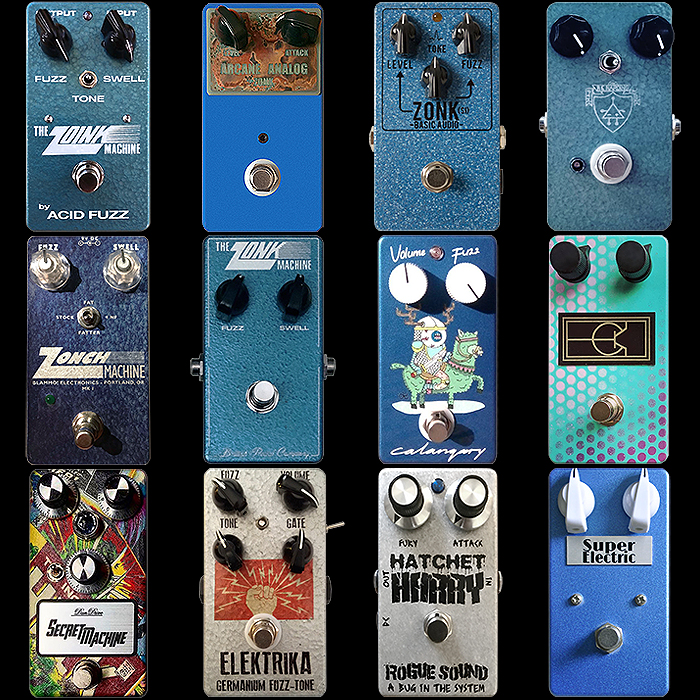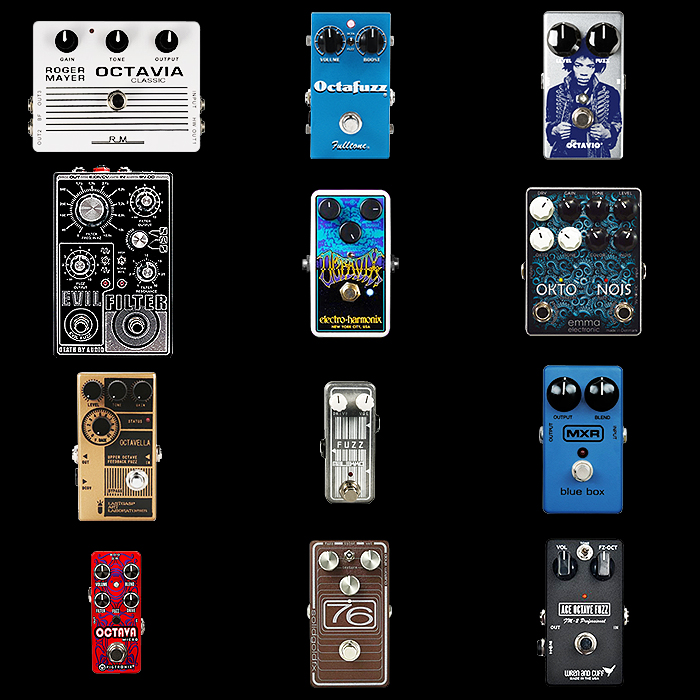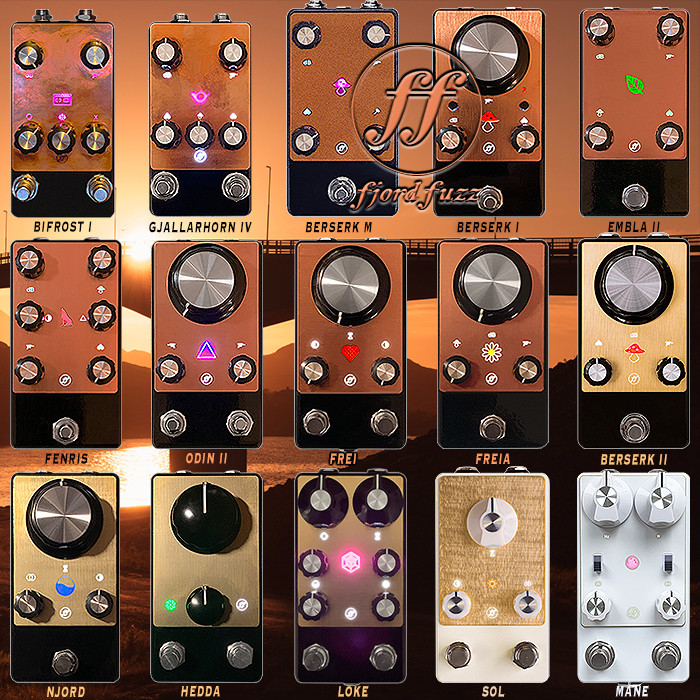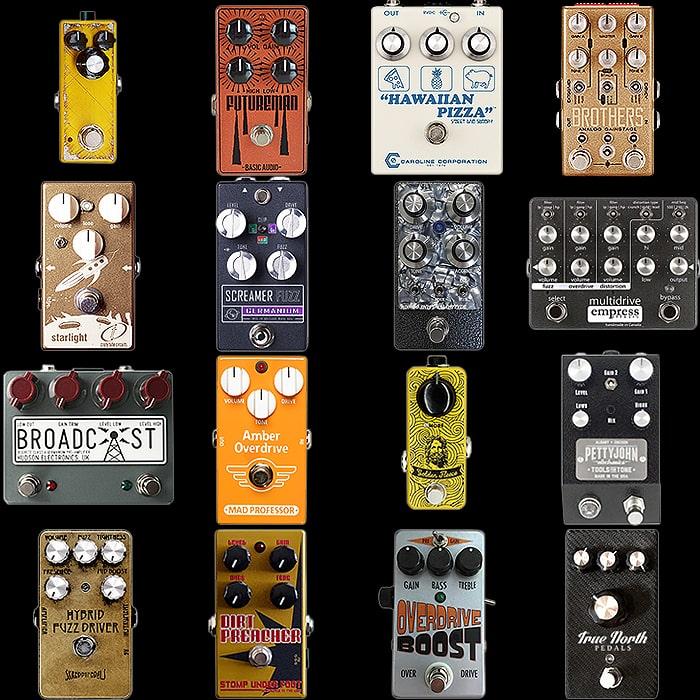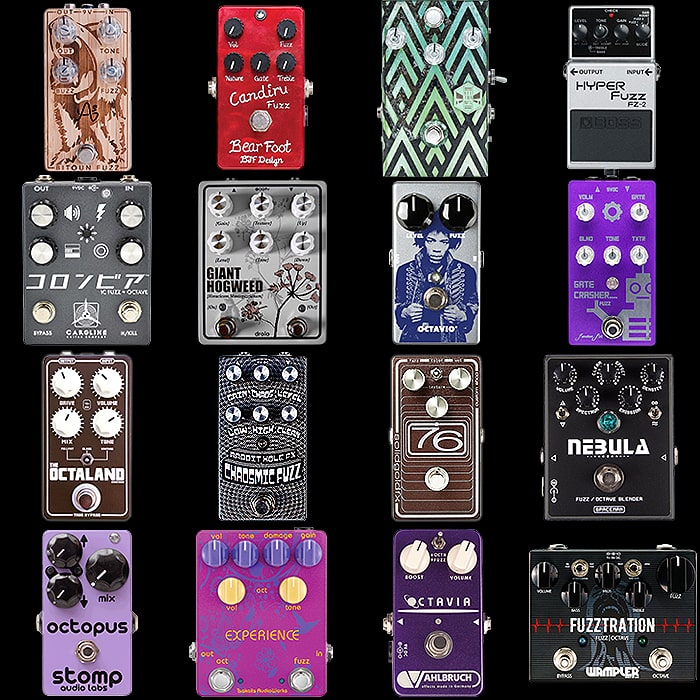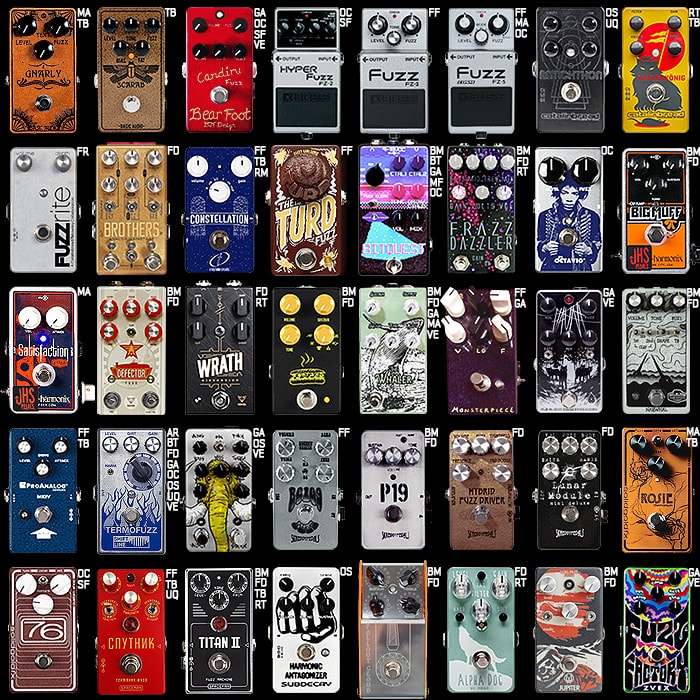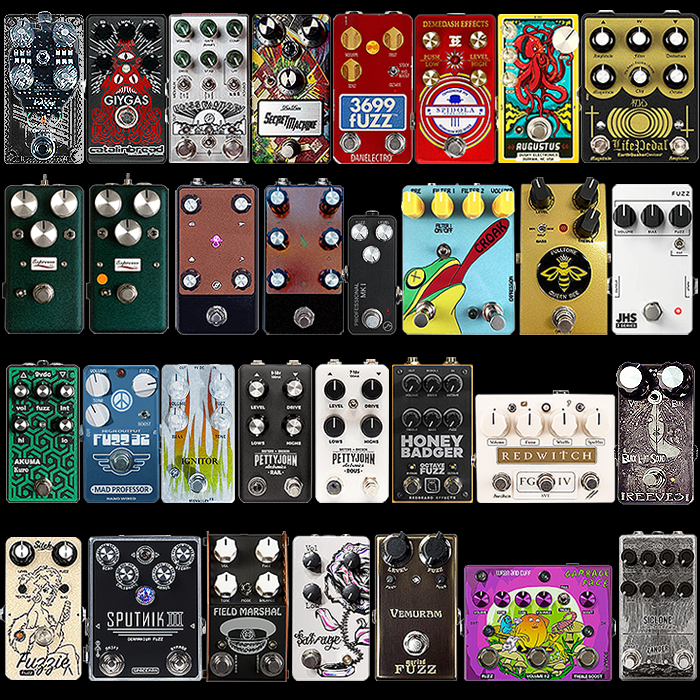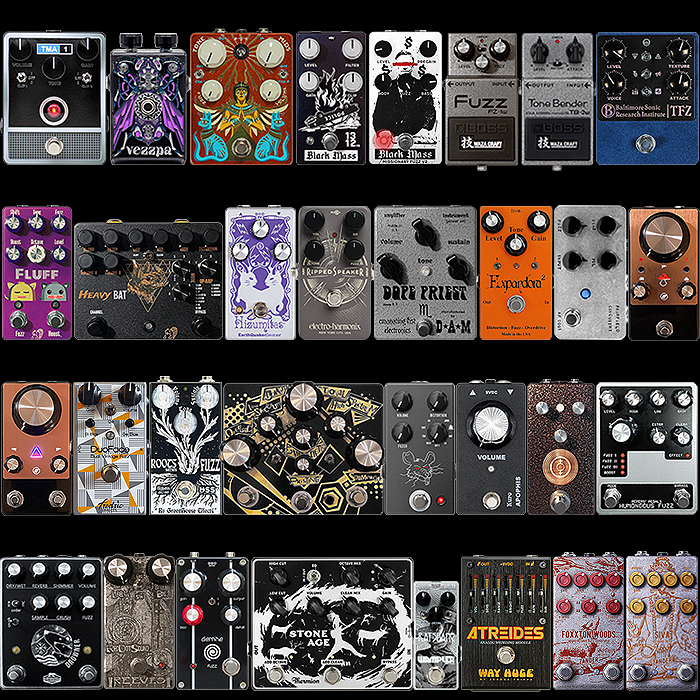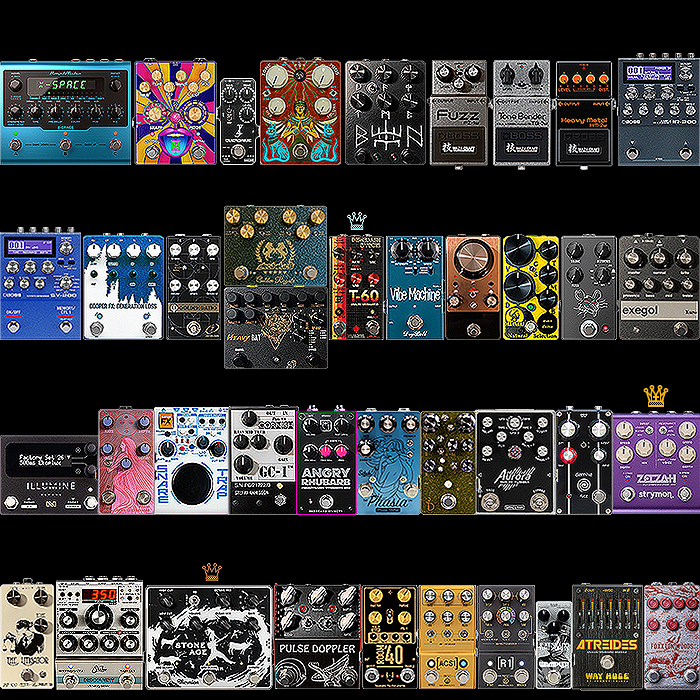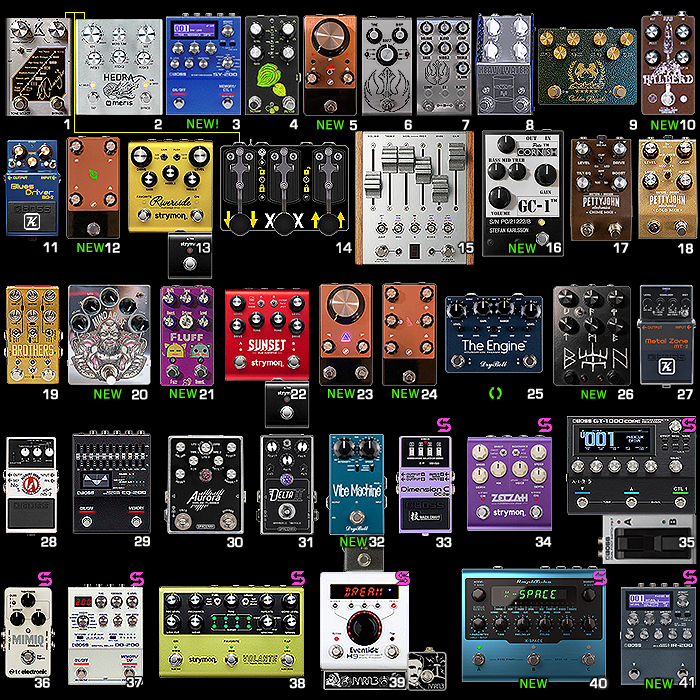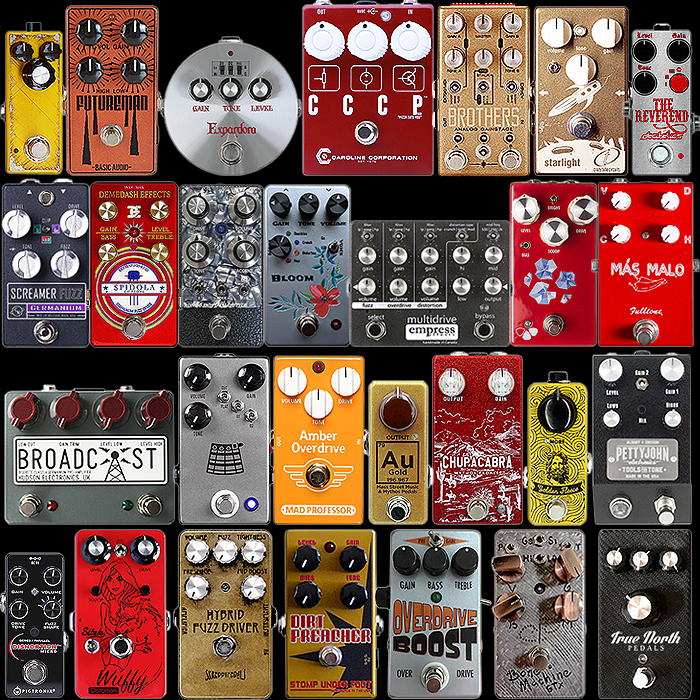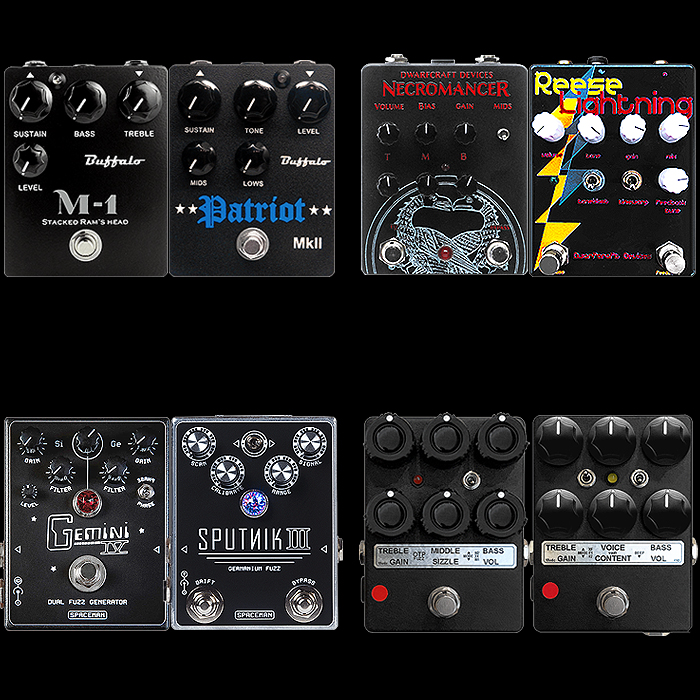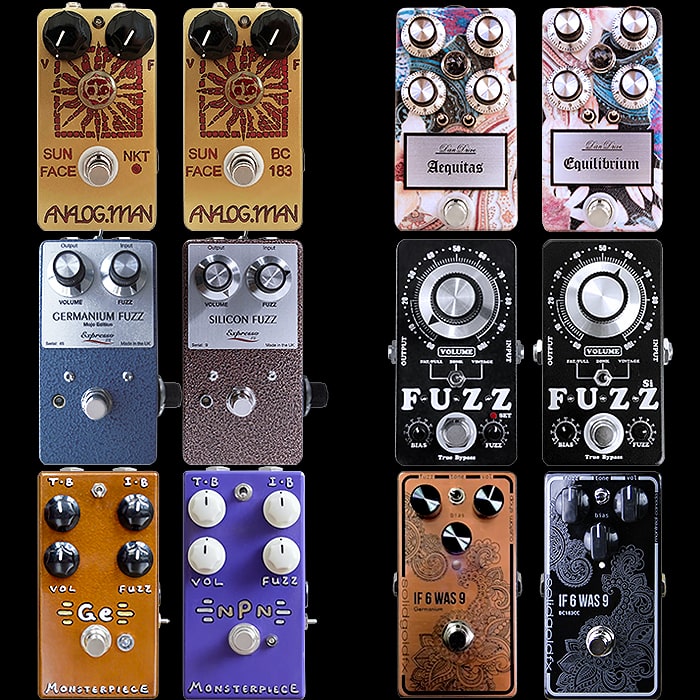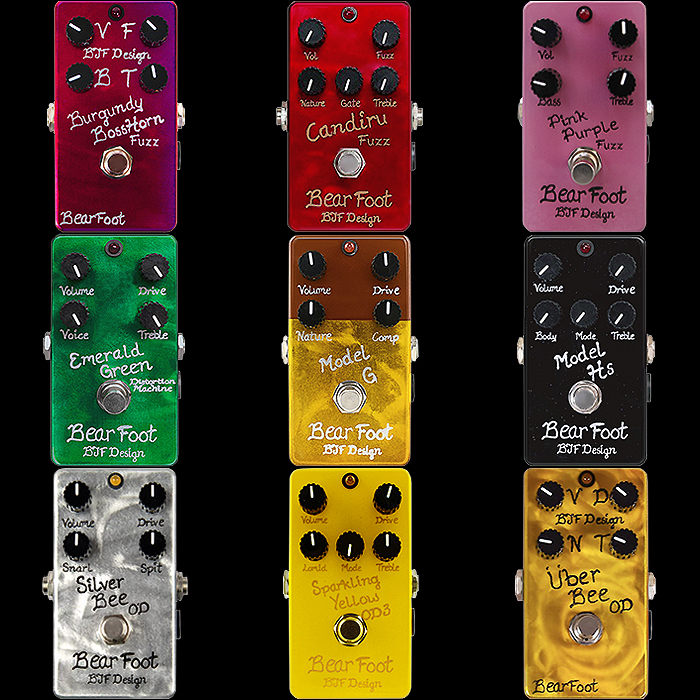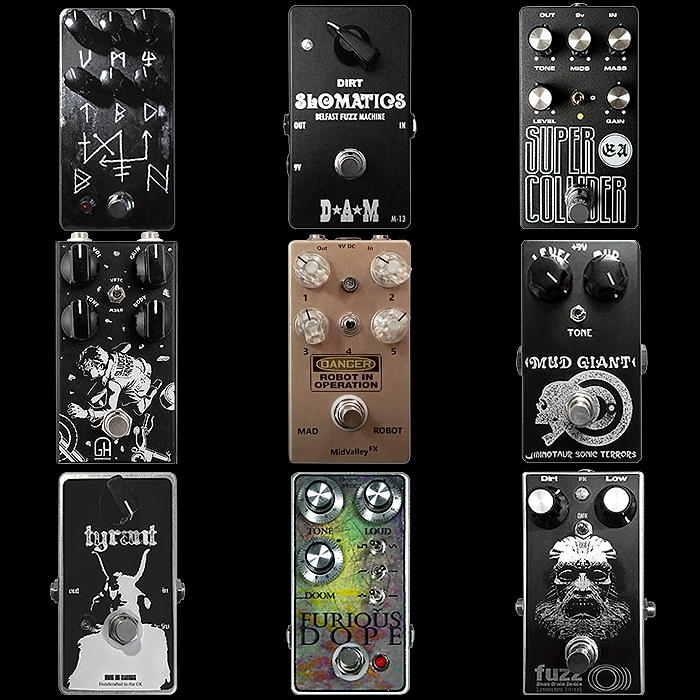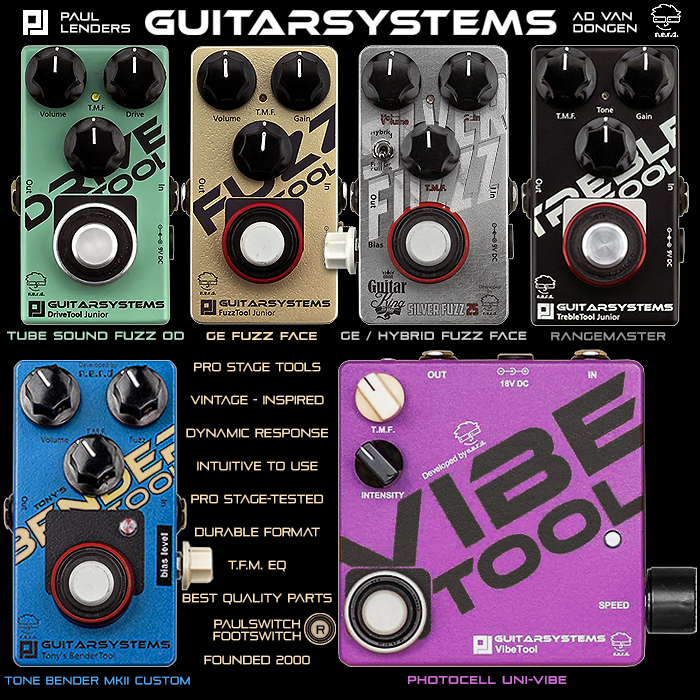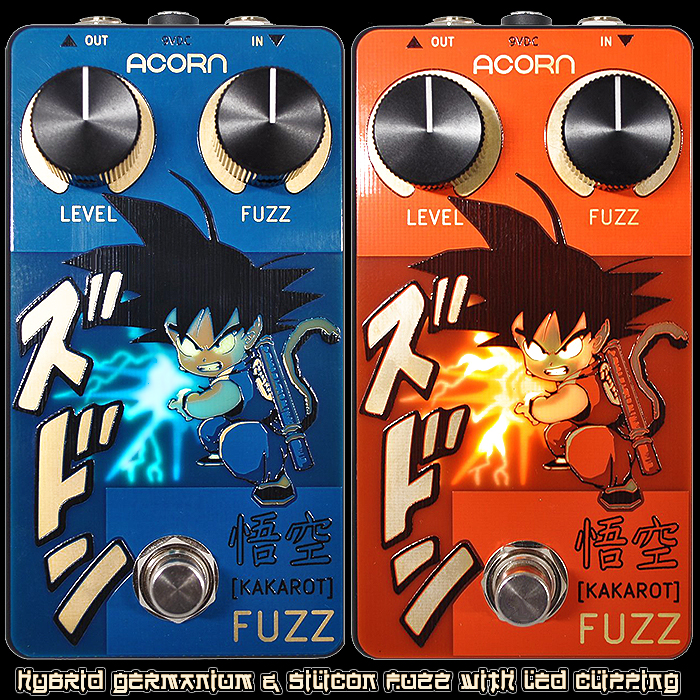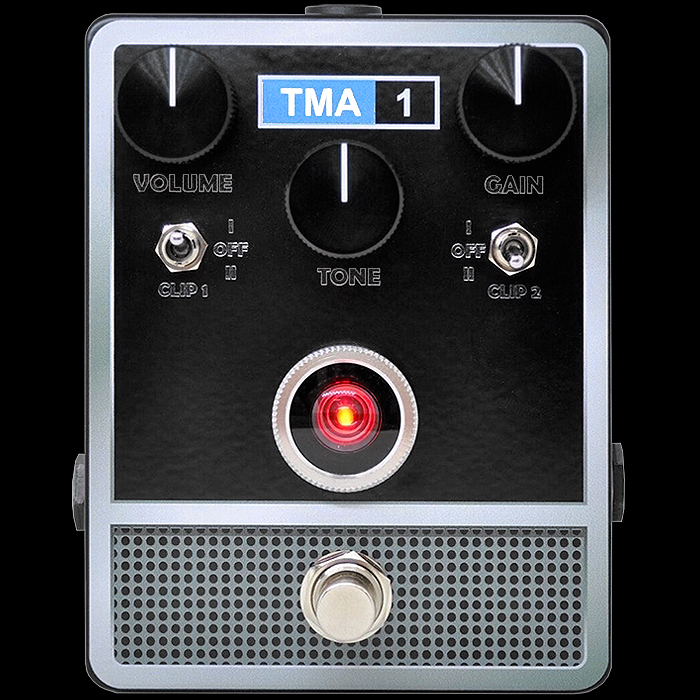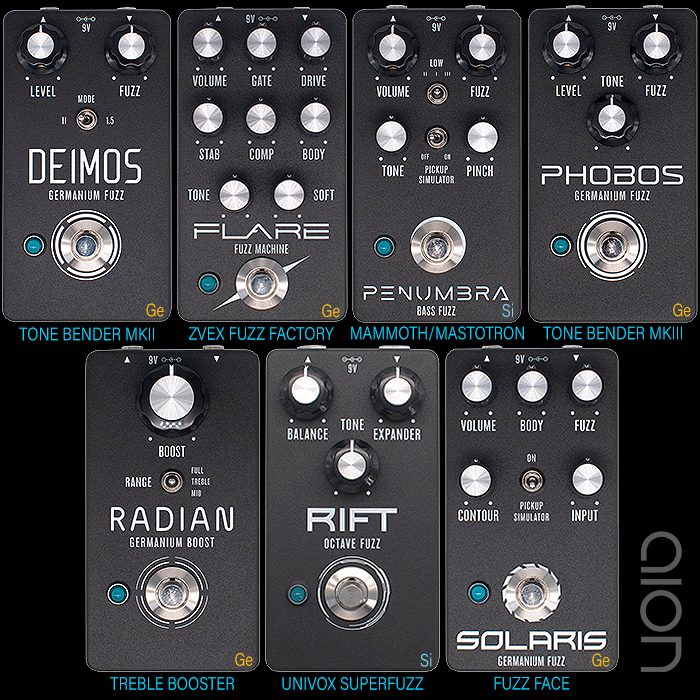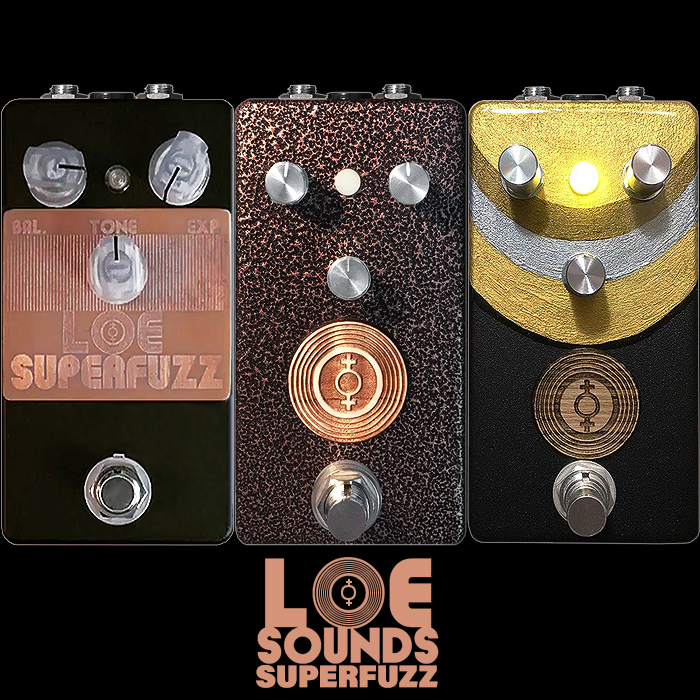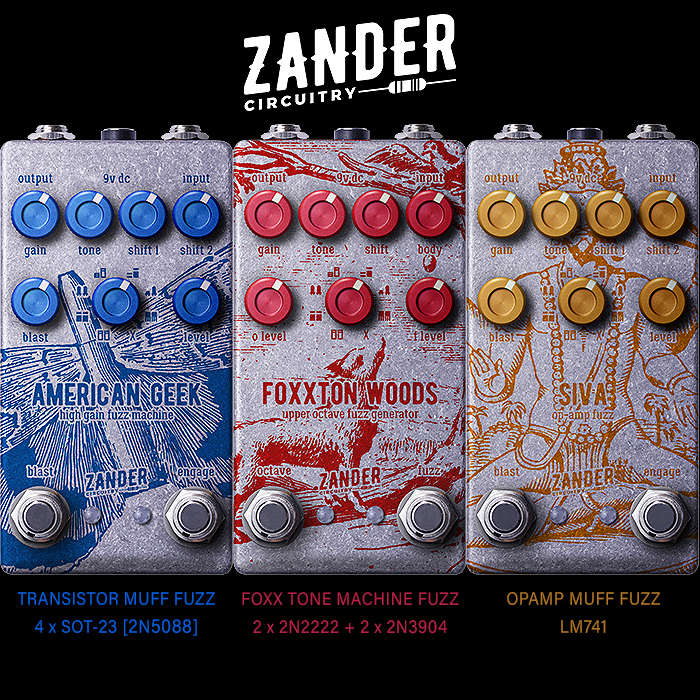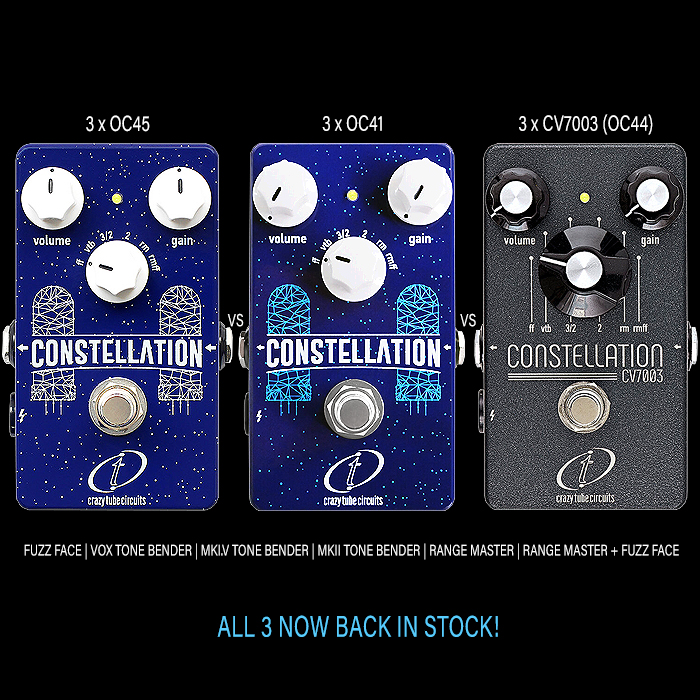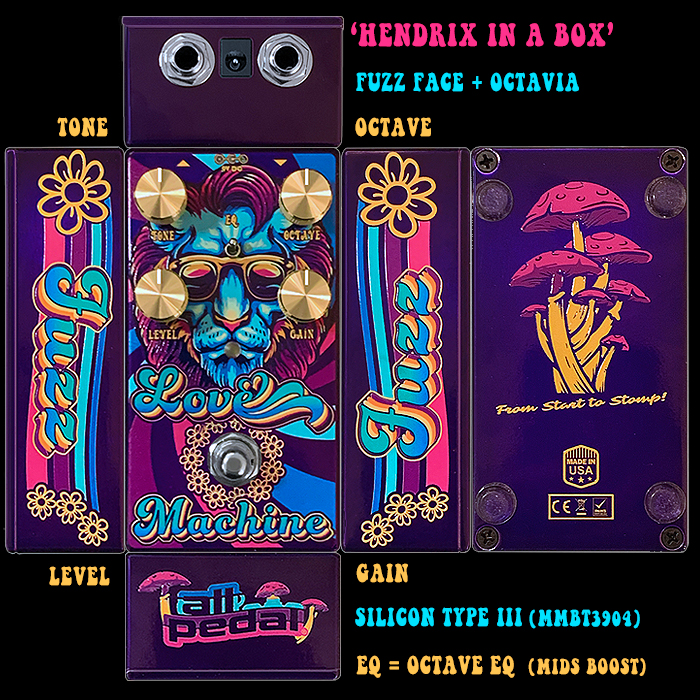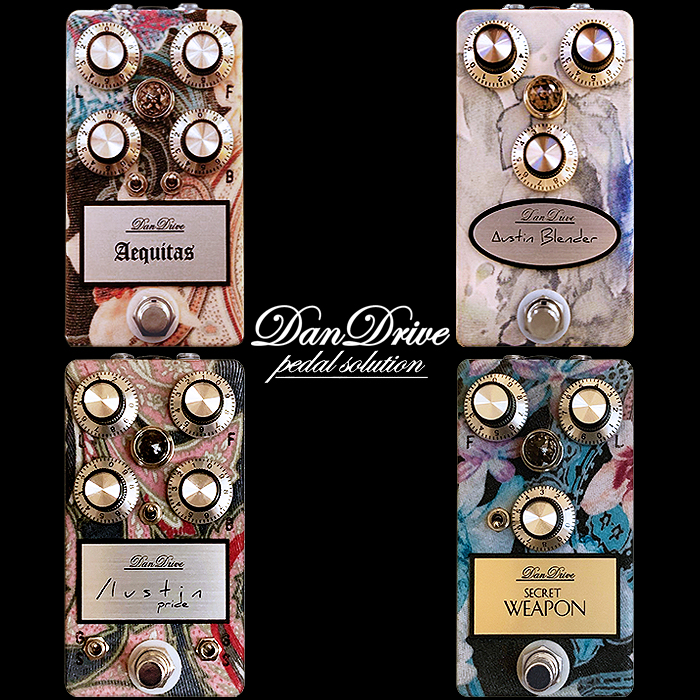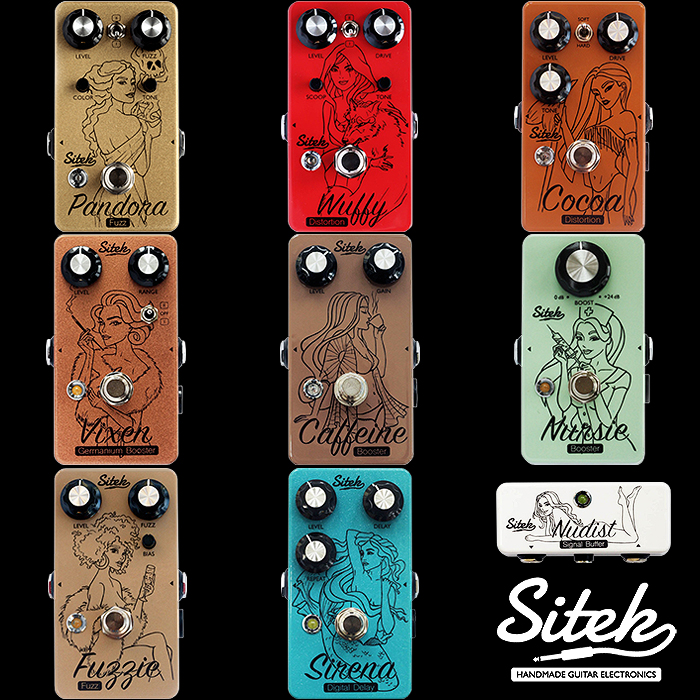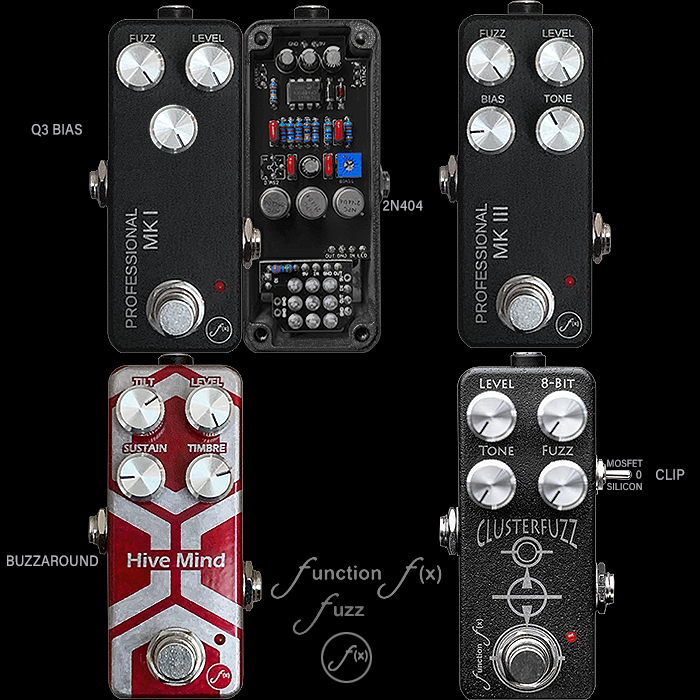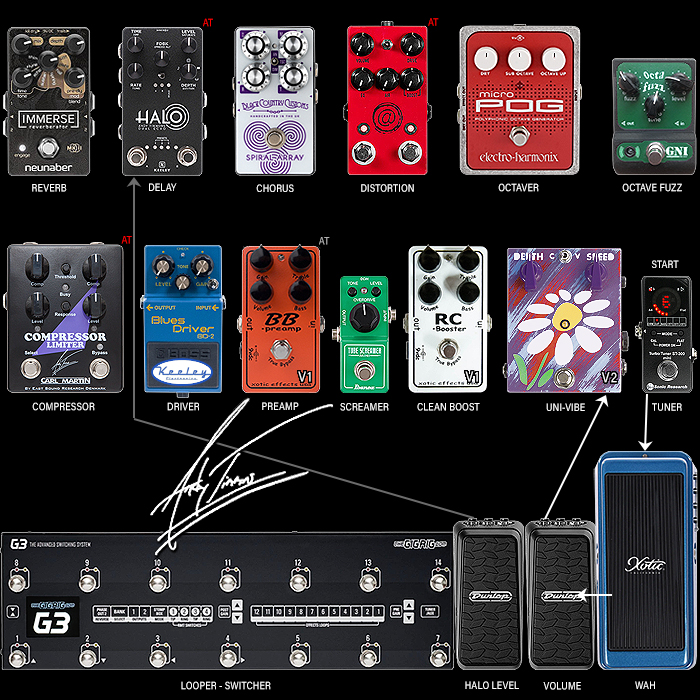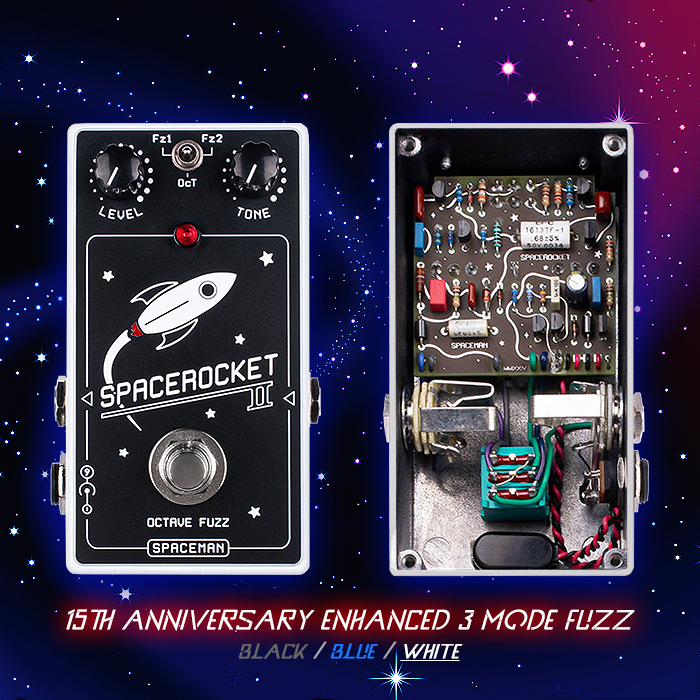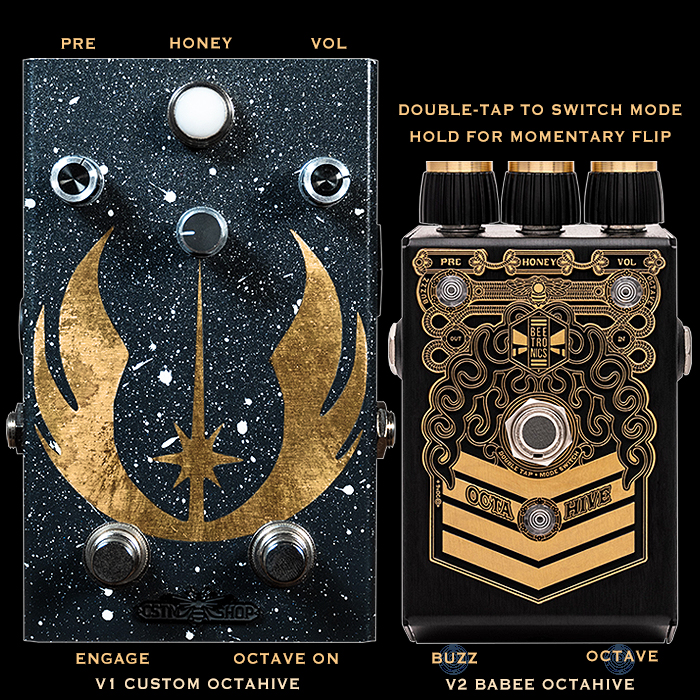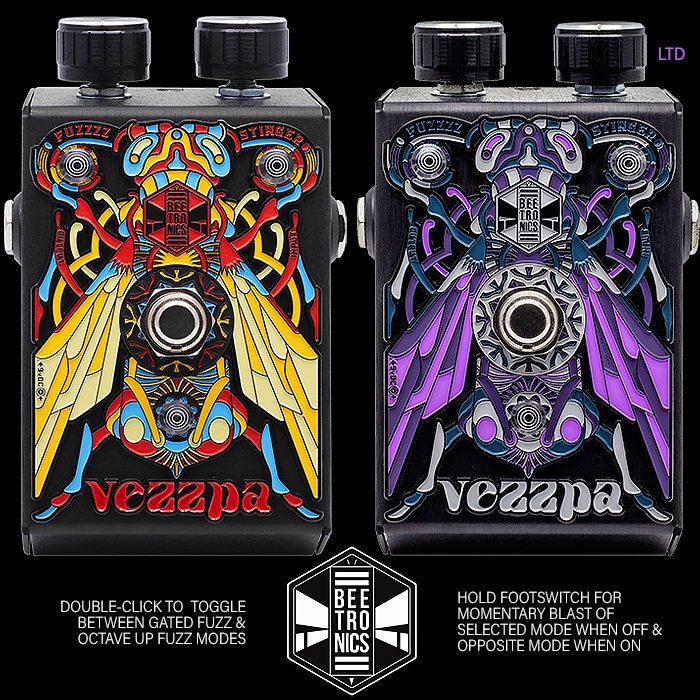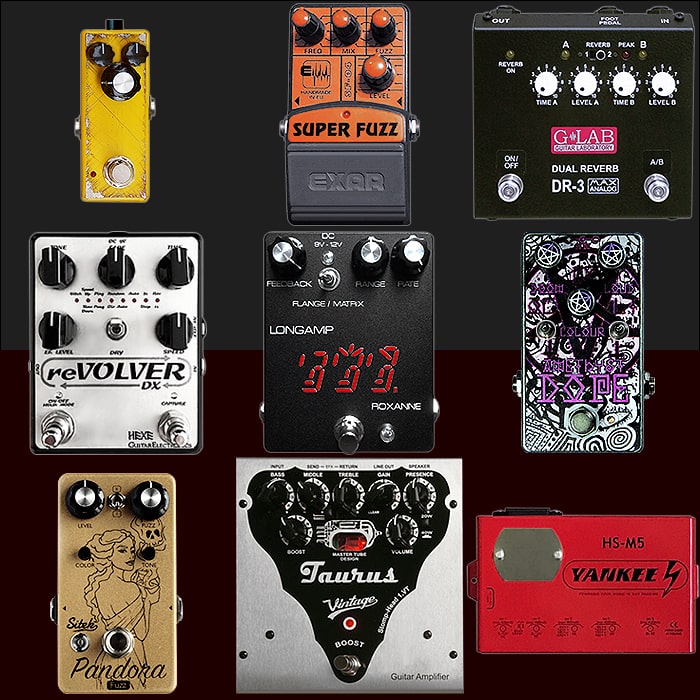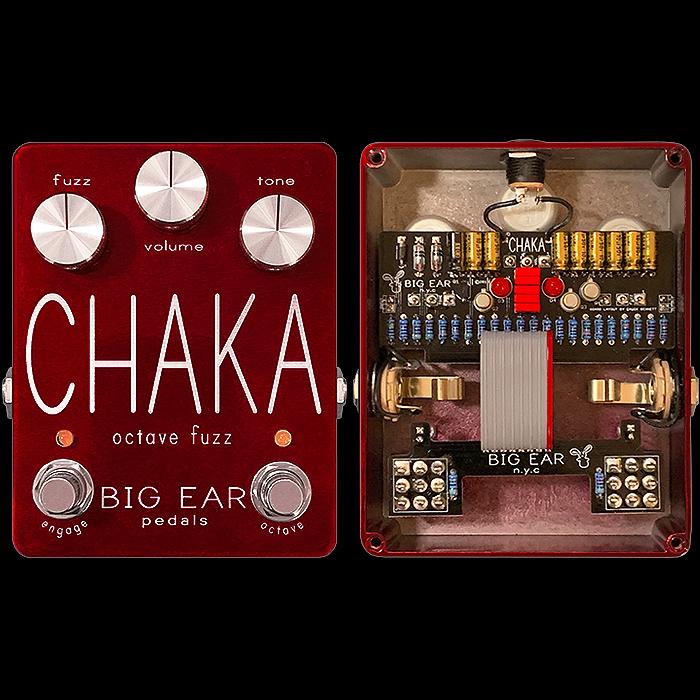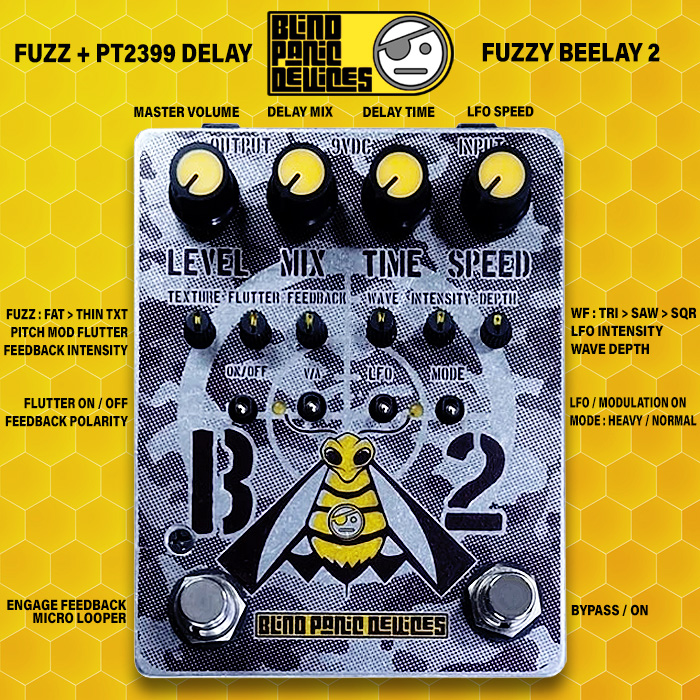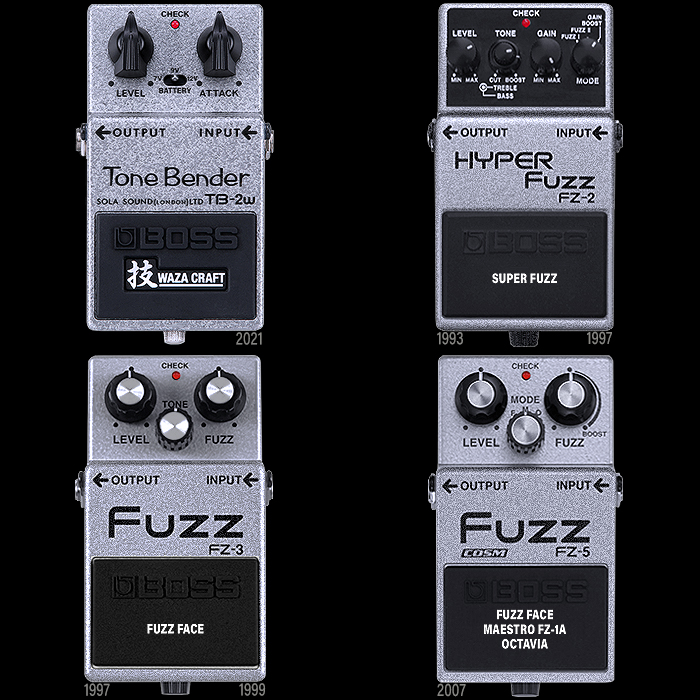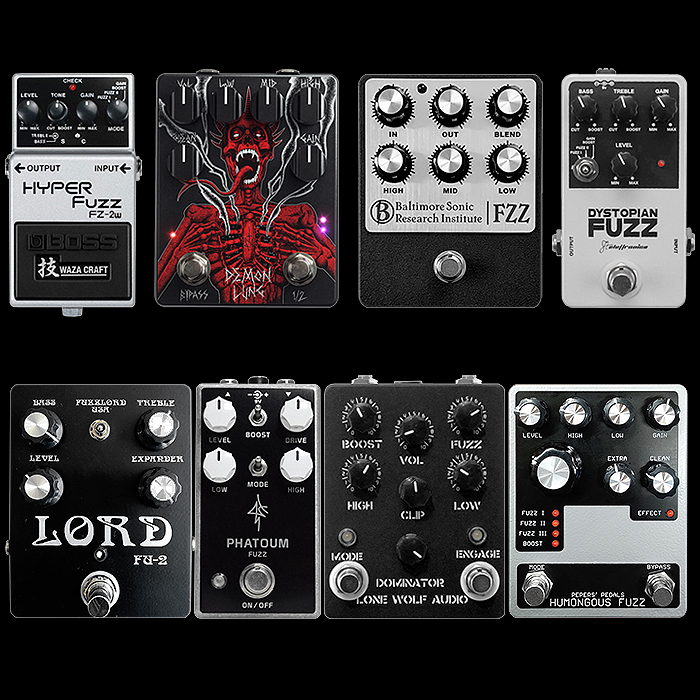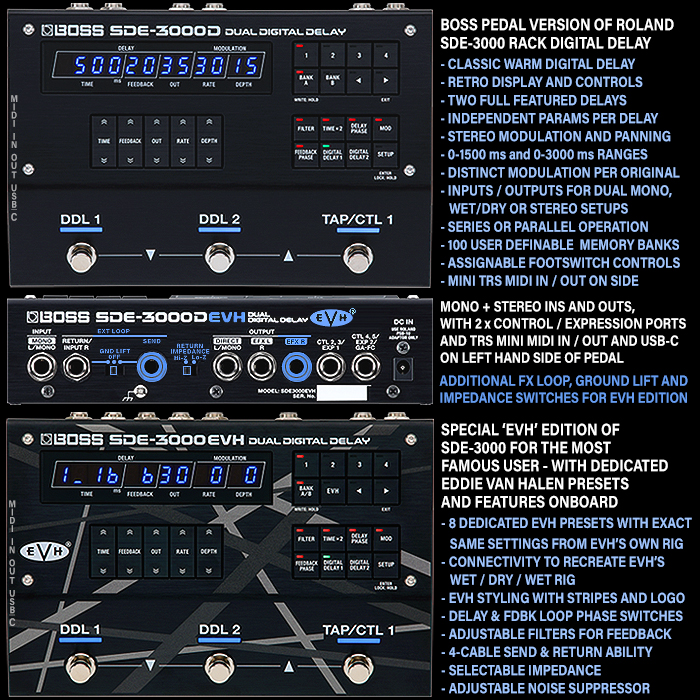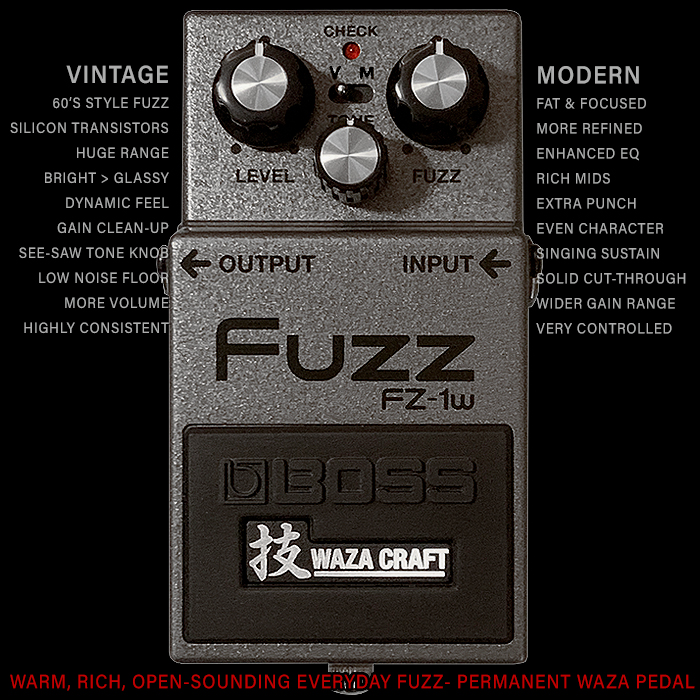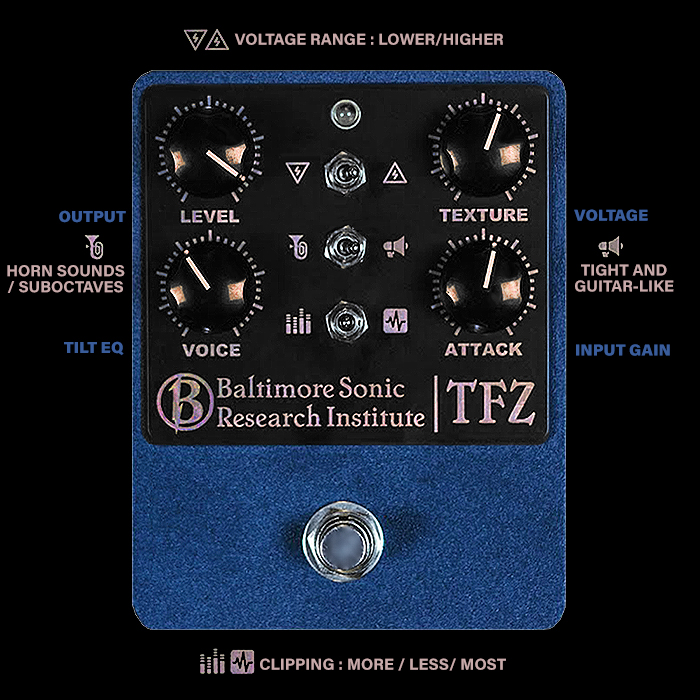Fjord Fuzz 2021 Range Revamp Launch - New Varieties of Berserk, Bifrost, Embla, Fenris and Odin Fuzz / Delay Pedals
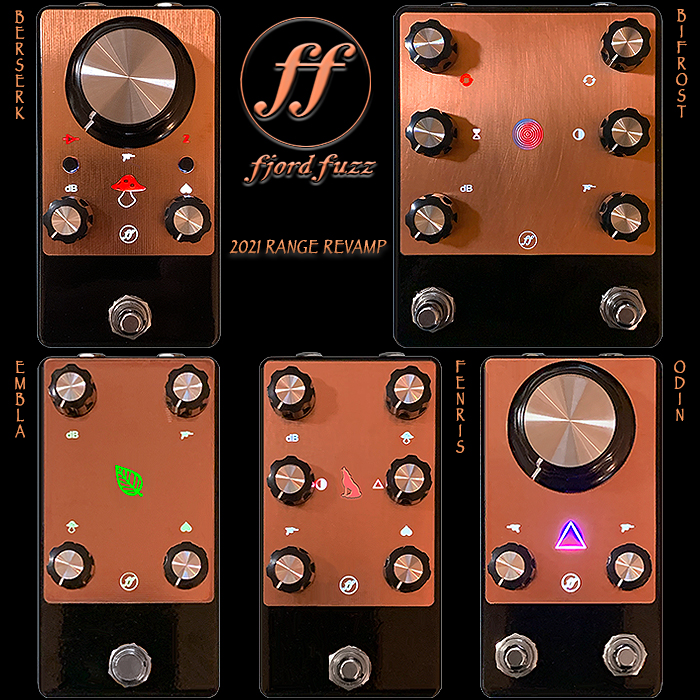
I feel very privileged and honoured to be a long-standing friend of Daniel Thornhill - whom I believe to be the King of the Modern Fuzz. In fact the ’FF’ acronym can be just as synonymous for Future Fuzz as well as Fjord Fuzz - as Daniel mixes up the very best of old and new to create the most extraordinarily visceral and lively of fuzz textures.
Daniel’s circuits generally use super-reliable high-consistency modern components which allow him to hone each circuit to the finest degree - while Daniel is not one for putting in artificial limiters - and his fuzzes generally range a lot rawer and more raucous than equivalents in terms of their nuanced fuzz texture and output.
I got drawn to Daniel’s pedals originally for the form-factor - which consists of LED-illuminated Copper facia plates - with etched symbols that shine through the functional purpose of each knob. The illuminated Copper on gloss black enclosures was a very strong look when it first evolved around 4 or 5 years ago, and it’s still enduringly modern and appealing today. The aesthetics of Daniel’s pedals are just as distinct as their output profiles.
I feel very privileged to have been the first to have received the whole of the new range - which includes a brand new variety of Berserk - where Daniel has solved all the typical issues of your average Fuzz Face circuit. The Berserk is Daniel’s excellent evolved take on that circuit.
These are some of the very best fuzzes available anywhere and each offers something distinct and unique!
The Symbols
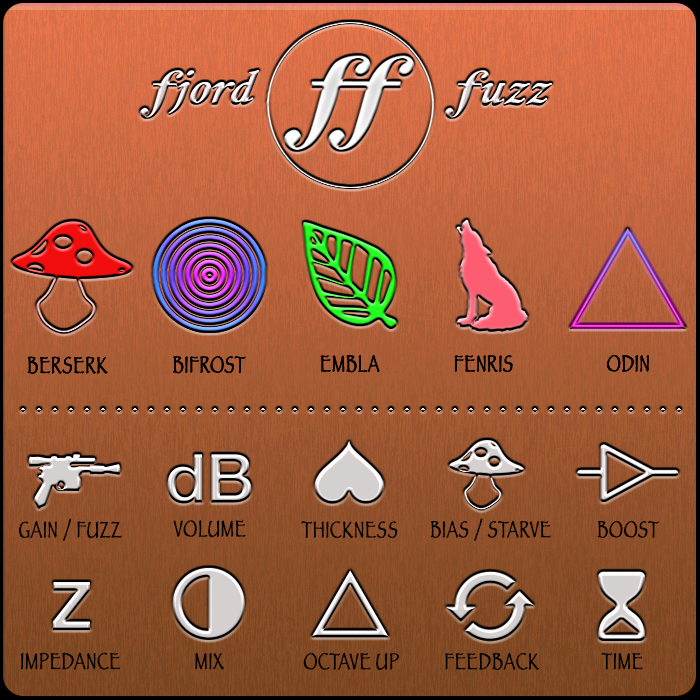
Above is a quick cypher for the various functional symbols - for in-depth descriptions and the origin stories of those - please refer to my previous Fjord Fuzz Symbology article from last week.
The Copper-Coated Etched Facia Plates
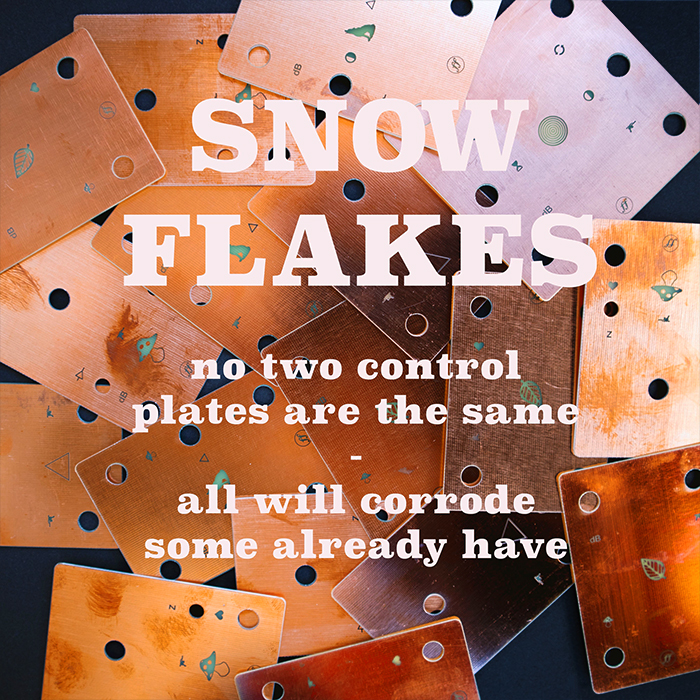
The most significant aspect of the Aesthetics of the Fjord Fuzz Pedals is the Copper-Coated Facia Plates that sit on top of the gloss black enclosures. What we have is a semi translucent layer of resin coated with copper - and where the copper is laser-etched away to form the functional symbols - which are then back-lit by LEDs.
Daniel very deliberately does not apply a varnish on top of this - meaning that the copper reacts to the acids in you finger tips, and within the environment - and over time the facia plates become patinated and tarnished in various interesting and artistic ways.
As the above visual attests - the copper coating process has some degree of variability - so that even from the start there may be slight variances in the exact hue of the copper. My 5 new ones currently gleam with a sort of golden copper luminosity, while in a number of my earlier Fjord Fuzz pedals - the copper leans more towards the pink side of the spectrum - and some of those earlier varieties were very deliberately patinated from the outset - while for current batches the panels start off pristine.
Daniel typically applies different coloured LEDs for Pedal Symbol and Functional Symbols, but there is also a further use of Red LEDs for some functions here. The backlit aesthetic in combination with the shiny copper makes for a really attractive look and feel. If you want to minimise patination - wear gloves when handling these pedals! Generally the appearance of those copper facias will change and evolve over time!
Key Components
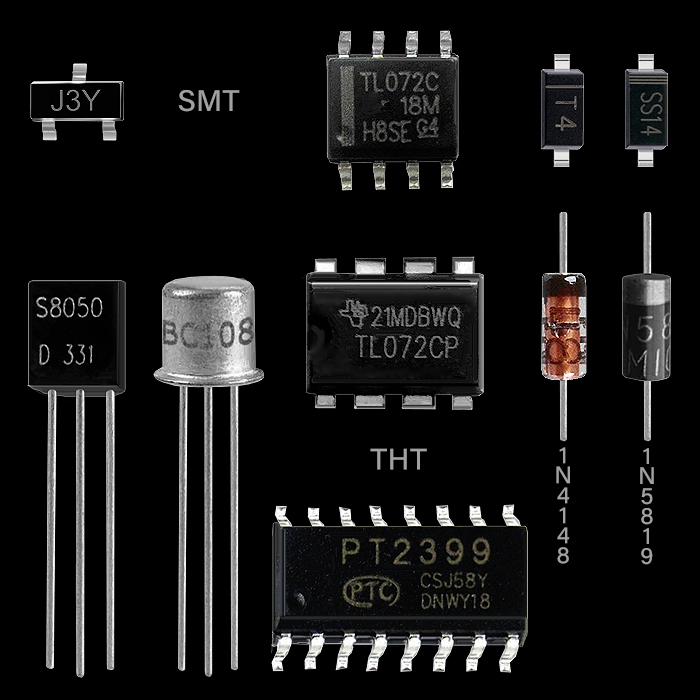
With Parts Supply / Supply-Chain issues affecting pedal-builds world-wide, Daniel has made a concerted effort to ensure a regular supply of components. Which invariably means that SMT variants are typically most consistently available.
I've listed Daniel's in the main SMD/SMT parts alongside THT equivalents where relevant. Where the only intentional THT part is the really cool metal-can BC108B variety for the Berserk - that just sounds better and more dynamic - with more texture than the SMT equivalents for that application. Initially Daniel had 2N4123 for Q1 and 2N4704 for Q2 - while he got much better results with the BC108B's so they then became the default there. In pretty much all other Fuzz applications - the S8050 equivalent SY3 is deployed in various numbers and combinations.
All other key tone-generation parts are SMT varieties - with the exception of the PT2399 Delay chip - where the SMT version is globally out of stock - so Daniel has had to use the full-size THT equivalent for that application.
Generally where exact equivalents exist - then SMT components tend to be more consistently robust and reliable. While there are still some extraordinary THT parts which currently don't have any proper SMT equivalents. And where Daniel has explicitly designed, tweaked and enhanced his circuits - based largely on the S8050 transistor variant. Maximum consistency generally leads to better overall quality!
Berserk Fuzz (Silicon Fuzz Face+) - $230
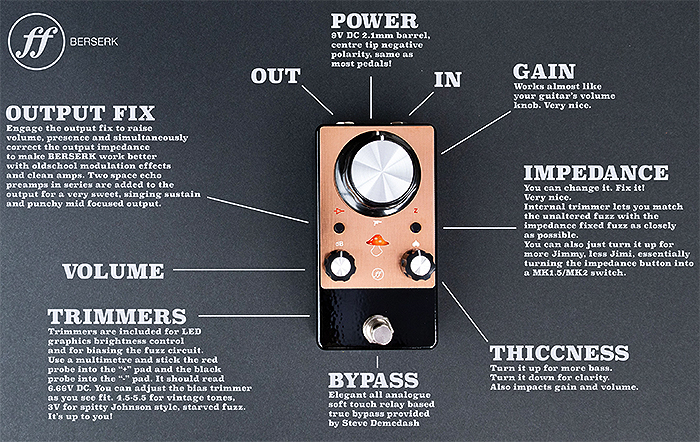
Key Components - 2 x BC108B Metal Can Silicon Transistors + S8050 / J3Y Silicon Transistor for Preamp/Boost.
External Controls - Gain, Volume, Thickness, Boost (Output Fix), Impedance (Input Fix).
Trimmers - Impedance, Output Gain, Bias, LED Trim.
Preferred Settings - Gain at 3 o'c, Boost On, Impedance On, Volume 3 o'c, Thickness at Max. Note that all 3 key internal Trimmers - Impedance, Output Gain and Bias are dialled fully back CCW. Impedance gives open voicing when on, buzzier / slightly gated voicing voicing when off - for those settings.
This is Daniel's latest pedal - and his take on a Type II Silicon Fuzz Face - where he tackles a number of issues with the original circuit - including enhancements for input signal and output. Traditional Fuzz Faces can be overly sensitive on the input side, and tend to be underpowered in terms of their output.
Daniel solves this by adding an Impedance control circuit - meaning that you get far more flexibility in the placement of the pedal - particularly as regards Wah pedals. And for the ouput he has added a preamp circuit to amplify / boost the signal.
There are 3 critical internal Trimmers here that you will likely need to adjust like I did, as the pedal comes set fairly neutral - while I like mine with a little extra zing! I found that the easiest thing to do was to dial all 3 of those key trimmers - Impedance, Output Gain and Bias - fully CCW.
The output is lively and vibrant and with the Impedance button off by default strays into slightly buzzier Tone Bender territory - while with Impedance on the sound is more open. I always tend to have the Boost switch on, and use the Impedance switch as a sort of voicing control - for less / more buzzy tones.
Part of me would have liked to externalise one or two of those trimmers, but I wholly understand why Daniel constructed the pedal in the way that he did. This really is a great Silicon Fuzz Face with smart added features and enhancements for extended versatility and granularity. And those BC108B transistors really sound great!
Bifrost Dual Feedback Delay + Fuzz - $300
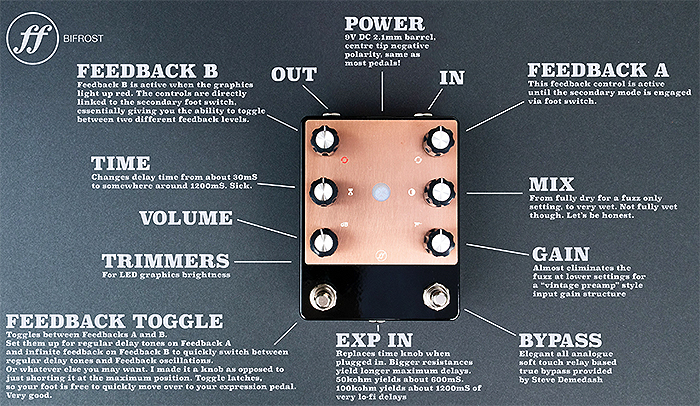
Key Components - 2 x S8050 / J3Y Silicon Transistors + TL072 Opamp for Buffer & Mixers + PT2399 for Delays + 1N4148 / T4 Clipping Diodes.
External Controls - Feedback A, Feedback B, Time, Mix, Volume, Gain.
Trimmers - 2 x LED Trim.
Preferred Settings - Feedback A at 9 o'c, Feedback B at 3 o'c, Time at 9 o'c, Mix at 3 o'c, Volume at 12 o'c, and Gain at 3 o'c.
This is essentially Daniel's perfect delay pedal - obviously based on the PT2399 chip, and with a stripped-down Embla added to create the most amazing wall-of-sound Fuzz-Washes.
I have the 5-knob compact original Bifrost too - while it's really handy to have the two different Feedback options here for different emphasis - and quick ramping up from subtle to full-on.
A very elegant sounding delay in its own right, and an awesome fuzz-weapon with the Embla element engaged. This one's a lot of fun to deploy and those two Feedback options makes it a worthy choice in its own right. This newest version has a pulsating rainbow colour-changing LED - with looks really cool!
Embla Everyday Fuzz / Fuzzy-Drive - $220
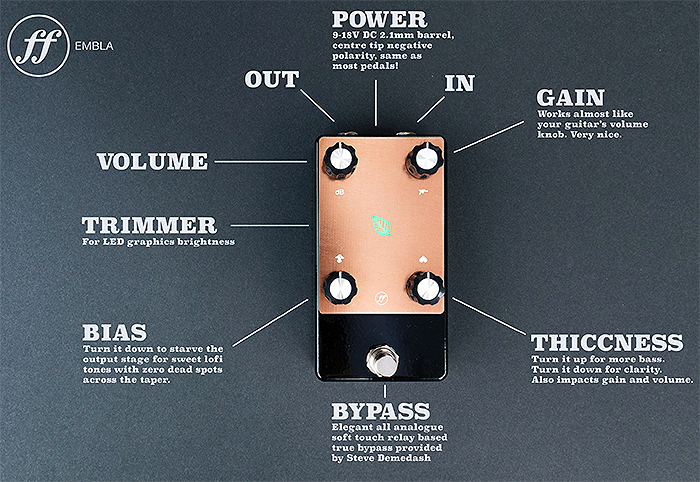
Key Components - 2 x S8050 / J3Y Silicon Transistors.
External Controls - Volume, Gain, Bias, Thickness.
Trimmers - LED Trim.
Preferred Settings - Volume at 3 o'c, Gain at 10 o'c, Bias at 9 o'c, Thickness at 3 o'c.
I still feel in many ways that this is Daniel's flagship pedal - very originally derived from a Bee Baa circuit while evolved into something quite different. Daniel's intention was always to create a fuzz pedal with very much overdrive characteristics - and a huge range of tonal and textural possibilities where you could go from subtle overdrive, through fuzzy-drive and into full-on buzzy fuzz.
I foolishly did not have this in mind when I did my last Fuzzy-Drive pedals roundup - for this is surely one of the best Fuzzy-Drive pedals of all time. Where each of Gain, Bias and Thickness controls are highly interactive. For more overdrive-like sounds you simply dial back each of those knobs.
This can sound subtle and elegant at one end, and fully thick and buzzy at the other - just superbly versatile - and the very epitome of an Everyday All-Rounder Fuzz. If you only ever get one Fjord Fuzz pedal - it should probably be this one - just supremely adaptable and versatile.
Fenris Harmonic Octave Fuzz (Super Fuzz+) - $240

Key Components - 5 x S8050 / J3Y Silicon Transistors.
External Controls - Volume, Bias Gate, Filter Mix, Octave Bias, Gain, Filter Depth.
Trimmers - LED Trim.
Preferred Settings - Volume at 2 o'c, Bias dialled back fully CCW, Mix at 2 o'c, Octave Bias at 11 o'c, Gain at 3 o'c, and Thickness dimed out fully CW.
Daniel's take on the Super Fuzz is beautifully visceral and full-on, while also being incredibly nuanced and controllable with those 6 dials. The main Bias gets increasingly buzzy and starved as you crank it up - more open and consistent when dialled back - like I mostly have it.
I have the earliest predecessor to this too - the Gjallarhorn - and this takes it really to the next level. You can go focused and searing or fatter and thicker here - with everything in-between. This sounds really immense and cutting - and is surely one of the very finest examples of its kind. There are few to none Super Fuzzes with this much versatility and control.
You can get a really cool foghorn-like wall of sound on this - it's just an extraordinarily textured fuzz.
Odin Octave Fuzz (Foxx Tone Machine+) - $200
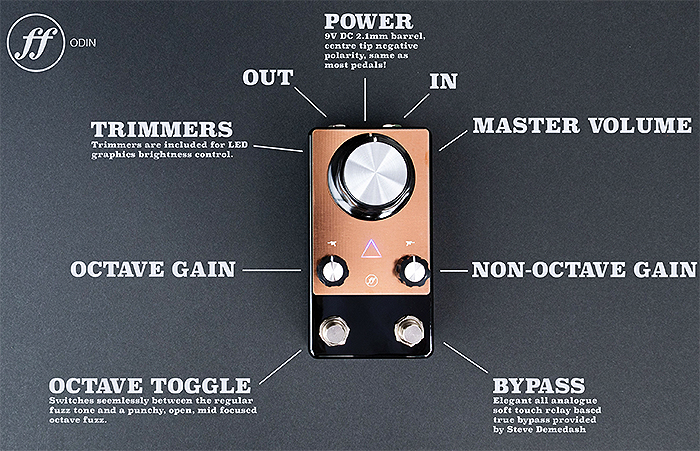
Key Components - 6 x S8050 / 3JY (3 per side) + 1N5819 Octave Diodes.
External Controls - Master Volume, Octave Gain, Non-Octave Gain.
Trimmers - Octave Gain LED Trim + Gain LED Trim
Preferred Settings - Volume at 2 o'c, Octave Gain at 3 o'c, Non-Octave Gain at 4 o'c.
This is Daniel's smart take on the Foxx Tone Machine - where I also have its simple one-knob predecessor. I much prefer the added control you get via having Gain controls for each of the two fuzz voicings.
The Searing Clarity of the Octave voicing really is next level - the octave is clarion clear and consistent - really full-on which you don't always get with similar takes. The Octave voicing is really where it's at here and is actually rather elegant in some ways for all its searing intensity.
This is just a beautifully calibrated Octave Fuzz which really stands out amongst its peers.
Final Thoughts

What is brilliant about this selection is that all these fuzzes are totally distinct and their own thing - there is no overlap here really - apart from the fact that the Bifrost Delay also uses a stripped down version of the Embla Fuzz. But these are all so distinctly different that it's very easy to justify owning all of them!
When asking Daniel what his particular favourites are - his two go-tos are typically the Embla and Fenris. The Embla is the great all-rounder, and the Fenris is the full-on texture monster when you need to make things a little more edgy and attacking. While if you're looking for an Octave Fuzz there are few as consistent as the Odin.
The Berserk is obviously an enhanced take on the Fuzz Face and is different enough to justify ownership despite how many fuzz faces you already have. And the Bifrost - which is principally a delay pedal - is just enormous fun to deploy.
What all these pedals have in common is a huge range of usable tones onboard with proper extended range in most cases. And furthermore each of these is really relatively easy to dial in. You need to figure out the variances along the Bias tapers, but everything else lands exactly where you would expect it to - for really easy on-the-fly tweaking.
These are proper full-on fuzzes and each is richly textured and consistent in its signal delivery. Daniel continually tweaks and iterates his circuits to constantly tune and improve them - and as an example the Embla is well into double digits in terms of its true version number. All of these circuits have been honed over an extended period - and combine the best of controllability and versatility.
If you only get one - I recommend you start with the Embla, for two add the Fenris - and for your 3rd Fjord Fuzz it really depends on your preferences - while it will frequently be the searingly elegant upper octave of the Odin. All here are worthy though!
The new range is available direct from the Fjord Fuzz Webstore also from the Fjord Fuzz Reverb.com Store, as well as all the usual dealers :
DEALERS :
UK : Anderton's Music Co
USA : Little Box Effects
DANMARK : Effektpedaler
SVERIGE : These Go To 11
NORGE : Gitarhuset Bergen
AUSTRALIA : Pedal Empire
Stay tuned for further imminent Dealer announcements!







